Professional dealers
Scripophily collecting before the internet
The internet came into being August 6, 1991, but was originally accessible only by universities, scientists, and governments. Commercial businesses slowly accepted the technology and started acquiring domain names and posting early websites in the mid-1990s. In April, 1995, email as we know it today was released and long distance communication became dramatically easier and immediate. It took quite a while for technology to improve, however, so email was not broadly used for several years. Phone, fax, and physical mail remained the ways most dealers and collectors communicated with each other.
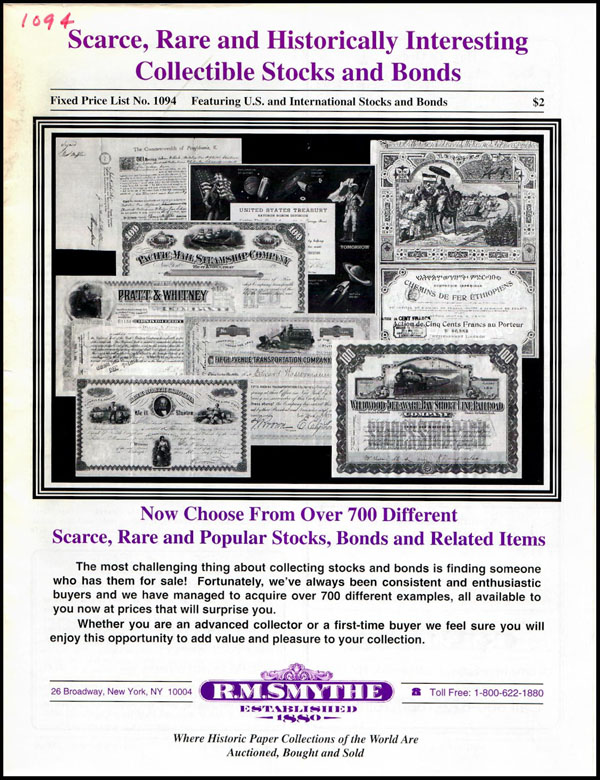
R.M. Smythe fixed price list, October, 1994
In order for collectors to build collections, most usually connected with dealers via ads placed in coin, stamp or paper collecting magazines/newspapers. Collectors willing and able to travel could often meet dealers face-to-face at shows in Strasburg, (Pennsylvania) , Memphis, and St. Louis. Most of the time, purchases were done through auctions, catalogs and phone calls. It was not at all unusual for dealers to send certificates "on approval" to collectors once they had established confident relationships. Collectors would pay for items they liked and return the rest. Not every transaction turned out well, but the vast majority did.
Dealers came in all sizes and shapes and most issued catalogs of some sort. Some "catalogs" were nothing more than mimeographed sheets with company names, single-line descriptions and prices. Many dealers offered occasional mailbids, sometimes by themselves and sometimes in conjunction with formal, live auctions.
Reaching dealers in today's internet world
A company called AuctionWeb appears to have been the first auction site that allowed average collectors to sell their own holdings in an auction format. AuctionWeb started in September, 1995 and changed its name to eBay in September, 1997. During that interim period, Bob Kerstein appears to have been the first stock and bond dealer to create a dedicated website called Scripophily.com in April, 1996. Freunde Historischer Wertpapiere and Scott Winslow & Associates followed in December, 1998, George H. LaBarre Galleries Inc. launched his site in March, 1999 and R.M. Smythe in mid-1999. I launched the non-commercial Coxrail.com site in June, 2000. Since then, many more dealers have set up websites in both the United States and Europe. Of course, many have also retired.
Registered websites now number over a billion, although only about 17% of those are active. Garnering attention in such a crowded environment is terribly difficult. Just because a dealer has a website does not mean collectors will find it immediately.
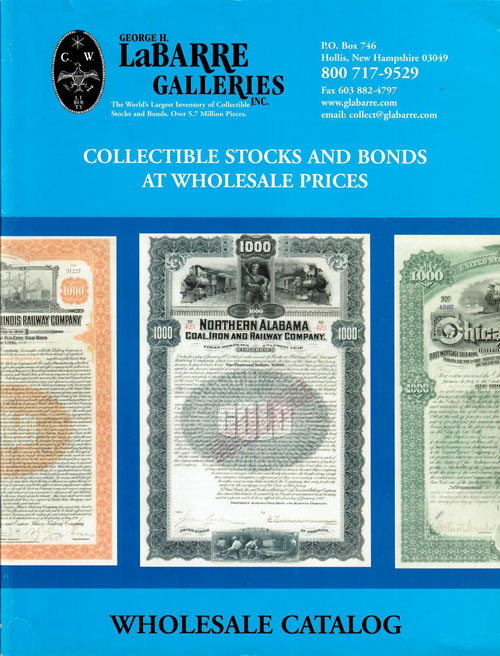
George LaBarre fixed price list,
June, 2005
Dealer websites generally need to be able to do business sell certificates, so consequently need specialized e-commerce programming to help them display inventories and accept payment. Several third-party providers claim to ease that pain, but pain relief comes at a cost. A steep cost in many cases.
Additionally, it is really quite difficult to do the programming necessary to handle auctions. There are many moving parts as well as timing and payment issues. The two largest third-party providers of online platforms for dealer auctions include:
The online world now owns the scripophily arena in North America. While there are still several bourses held in conjunction with European and German auctions, the only show dedicated primarily to stocks and bonds in the U.S. is the National Stock Certificate and Bond Show organized by Bob Schell and hosted near the Dulles Airport at Washington D.C. A few scripophily dealers attend the American Numismatic Association's World's Fair of Money, but the number is small and varies by year.
I offer a special page that lists all Scripophily Dealers I currently know to be active and who handle at least a few North American stocks and bonds.
The professionals
I know of only a few ways that North American hobbyists can compile collections of historic stocks and bonds:
Yes, one can occasionally find certificates in antique malls and flea markets. At present, there is really only one dependable way to compile advanced collections and that is through professionals, primarily by phone, email or website.
There are a handful of professional dealers who sell on eBay and collectors will be able to spot them by their more professional appearances. Most eBay sellers are either semi-pros or amateurs. Prices are usually low to absurdly low. If one wants to compile a collection of low-priced common certificates, eBay is the place to start. Moderately scarce to scarce items appear occasionally. But let's face it, a collector would need to set up numerous saved searches to find items they specifically want and even then, it will be very much a hit or miss proposition.
It is true that some advanced collectors sell scarcer certificates on eBay, but almost always when they are getting out of the hobby. A new collector can pick up some great deals during those periods, but they are unpredictable, limited, and subject to competition from other collectors hungry for the same items..
Professional dealers tend to keep deep and constant inventories of scarce and rare certificates. If collectors are looking for rarities, and don't want to wait a decade or more for the possibility of acquisition, these are the people to know. The same goes for professional auction houses, both in North America and in Europe. I advise in the strongest way possible for collectors to become acquainted with the pros.
Unless, of course, beginner-style collections are adequate.
High-price and low-price dealers and auction houses
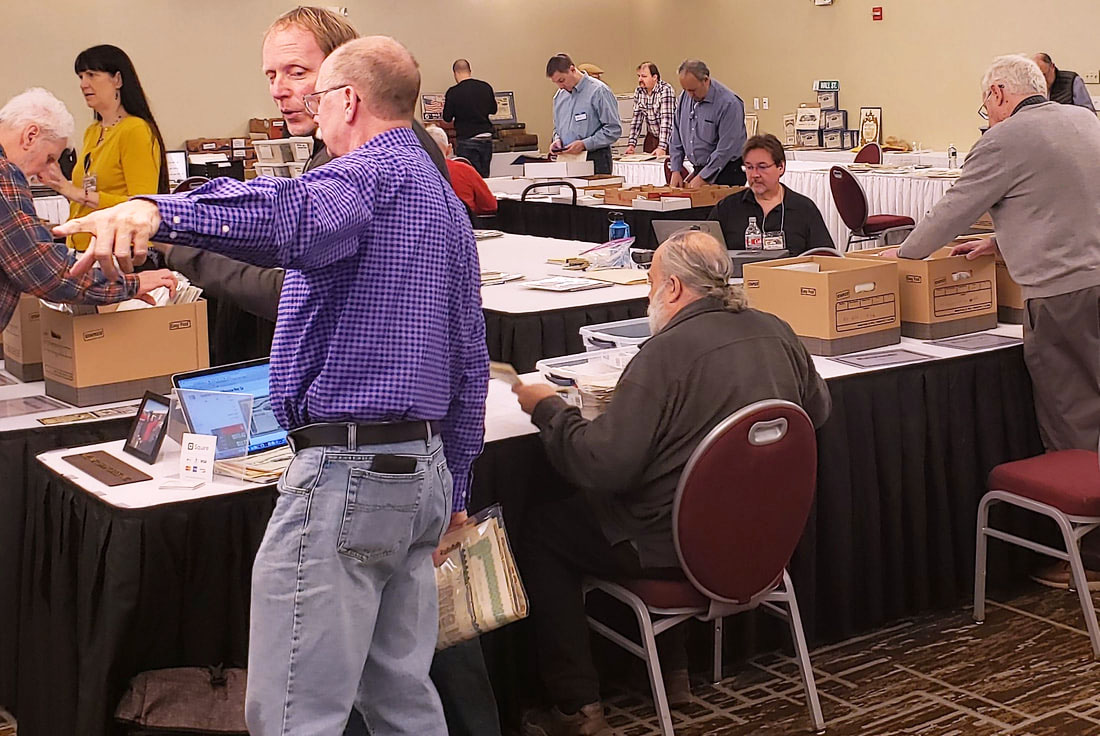
Professional dealers at the National Stock Certificate and Bond Show
Scripophily dealers and auction houses are arrayed exactly like every other segment of commerce. There are high-priced dealers and low-priced dealers. While there is overlap in their inventories, each part of the high price/low price spectrum tends to cater to a certain type of collector and a certain type of specialty. In other words they exhibit ranges like collectors themselves.
And like normal human relationships, collectors will naturally gravitate to the types of dealers they like the most. That can happen only if collectors do business with several dealers.
Regardless of the types of dealers collectors are attracted to, it is crucial to understand that dealers can exist only by making profits. Dealers will often give deals to their better customers, but never ask them to give away the farm. They can't and won't.
Through working with several dealers, collectors learn the nuances of the hobby and how to buy. Interactions don't need to be every day or even every month. Still, the more collectors work with dealers, the more dealers will learn who they are. Friendships result in better deals.
If calling on the phone, collectors should start with, "Hi, this is Bob Sayyourname," not, "Hi, this is Bob."
Dealers develop their own pricing strategies
Dealer base their selling strategies on hard-won experiences. Don't try to change them. That would be like trying to convince Wal-Mart to become more like Nieman-Marcus. Or vice-versa. It won't work.
Find dealers who fit your style — and your wallet.
Dealers specialize in different parts of the price spectrum
Price is the easiest way to attract the types of collectors they like to deal with. One of the toughest lessons for dealers is to identify their core group of collectors and focus on that group to the near exclusion of the rest. Consequently, most will offer a fairly wide range of prices, but their prices and selections will be different than other dealers who have different core groups.
No dealer can be all things to all collectors
Low-price dealers tend to focus on certificates they can sell quickly. They will tend toward common certificates, especially certificates they can find in volume. Low-price dealers try to make small profits on large numbers of certificates.
While low-price dealers tend to concentrate on common certificates, they will occasionally offer rarities. Problematically, their customer base may not jump on rarities immediately. Since low-price dealers do not specialize in rarities, their prices may appear too high. Or too low. Their method of operation is to "turn" their invested dollars quickly, so they may not be able to sell high-rarity items quickly enough.
High-price dealers tend to focus on the other end of the spectrum. As a rule, high-price dealers focus on highly-desirable certificates, even though such certificates may not sell quickly. Their inventory often represents one-of-a-kind items. Wealthy collectors may not think high-price dealers' prices are high at all.
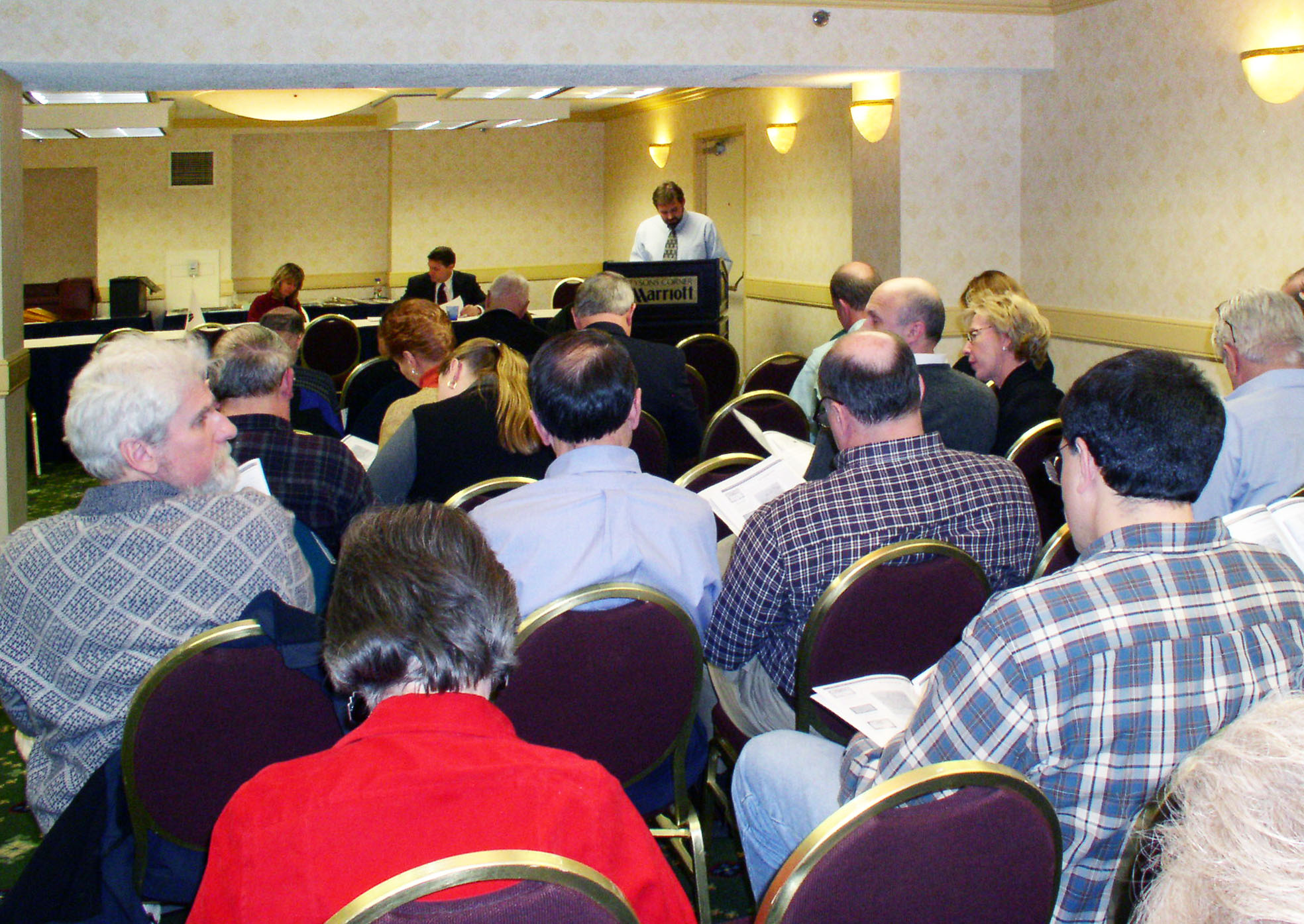
Scott Winslow auction at the National Stock Certificate and Bond Show, January, 2005
High-price dealers will generally offer a few common certificates. Unfortunately, their customer base may not buy common certificates quickly. The problem with high-ticket dealers selling low-priced items is that the dealers may not have the proper types of collectors in their mailing lists. High-ticket dealers also need to "turn" their invested dollars. Because their markup is often higher, they may not need to sell quite as many items or as quickly.
I hear complaints
- "How can he expect to sell those for so much?"
- "How can he sell them for so little?"
- "I know another dealer who is selling the same certificate for half that much!"
- "Oh, he just sells junk!"
These complaints show collectors are grappling with a difficult subject. Pricing operates in a relative vacuum. By that I mean that dealers are often so busy with their own businesses that they have little information about competitive pricing. Of course, their normal customers may be equally uninformed.
Understanding prices
Pricing is a subject that takes much experience to understand. Pricing is dynamic. The sooner collectors accept the fact that certificates are not commodities, the sooner they can come to grips with highly variable pricing. Every certificate is different. Secondly, experience will ultimately teach collectors that "list" prices are merely "ask" prices. Customers always have the option of asking for lower prices, and dealer always have the option of saying, "No."
Many factors go into pricing, and they vary radically from dealer to dealer.
- How many similar certificates does a dealer have in stock?
- How long has a dealer had certificates in inventory?
- How much did the dealer invest?
- Is the condition of the certificate better or worse than average?
- Has rarity changed because of new discoveries?
- Are other things in a dealer's life affecting prices? (Illness? Old age? Divorce?)
- What are the dealer's typical customers like?
A real life example
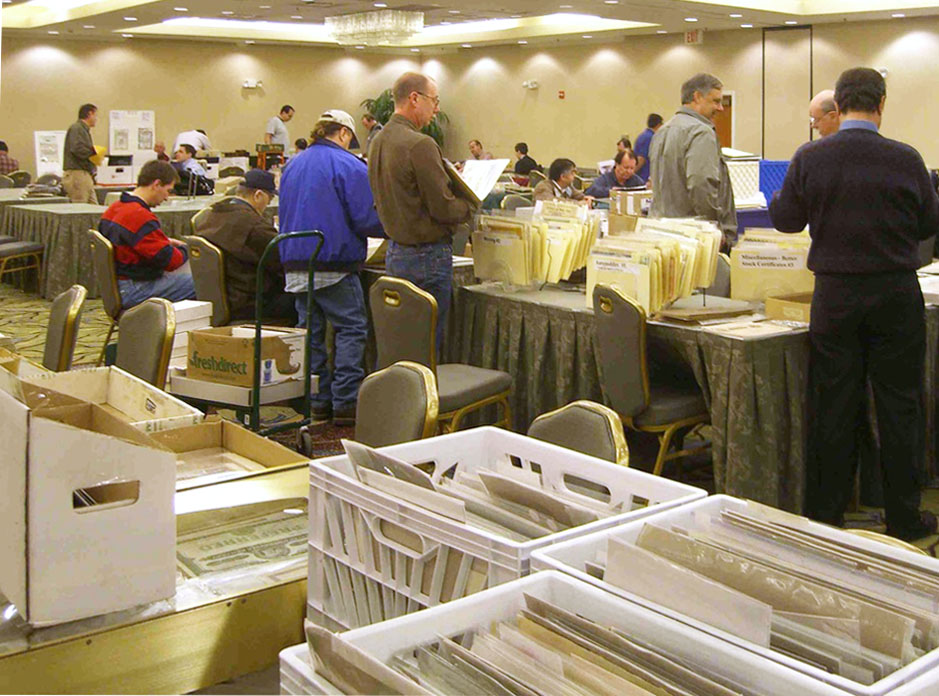
Professional dealers at the National Stock Certificate and Bond Show
I am not a big-time collector. My primary goal is to acquire certificates for examples. Nonetheless there are specific certificates I desire from time to time. Sometime around 2005, I created a "Saved Search" on eBay to alert me if one of my desired certificates ever appeared.
I was in no hurry, and I wanted to see how well eBay's Saved Searches really worked. Truthfully, the Search just sat there. Every few years I had to refresh the search so it would stay active even though no certificates were appearing. I knew of a few examples of my desired certificates from old auction catalogs and assumed one would eventually appear on eBay, sooner or later.
It turns out one DID appear in 2015, but my Search didn't alert me. The seller had misspelled the company name in a way I had not anticipated, so my search missed it. The certificate sold for less than $25 by which time I had been willing to pay substantially more. More years went by with no appearances.
I finally decided a fifteen-year wait was enough, even for a "collector" like me. I contacted eight professional dealers and two had my target items in stock. I quickly acquired several of my desired certificates in about a week! And at prices well BELOW what I was willing to pay.
The point? Waiting for a rarity to appear on eBay might pay off, but the scarcer the certificate, the slimmer the chances. Step up and play the game with professional dealers.